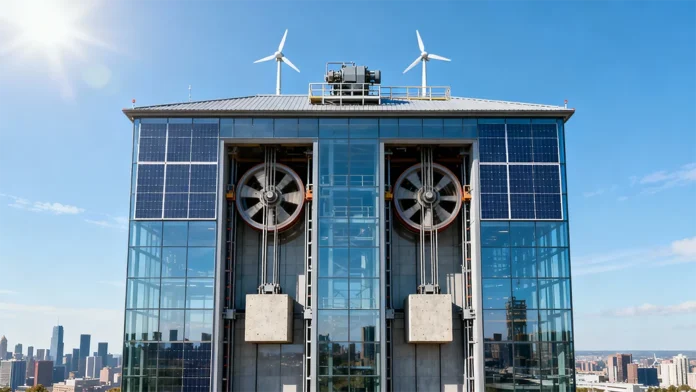Researchers at Canada’s University of Waterloo have come up with a solid gravity energy storage system that can be used to store renewable energy in the high-rise urban buildings.
This rope-hoist-based system happens to be designed to operate in combination with the photovoltaic facades, which are installed on the south, east, and west walls, and also small rooftop wind turbines along with the lithium-ion (Li-ion) batteries.
As per the proposed configuration, the gravity-based system goes on to serve as the primary energy storage unit, whereas the batteries are used just for fast-response storage at the time of significant production surplus or shortage. The system makes use of the energy generated by the PV facades as well as the wind turbines to lift a heavy mass that’s within a shaft at the time of the charging phase. This stored potential energy then is released to rotate an electric generator at the time of discharge.
The system happens to comprise a motor-generator unit, transmission gears, hoisting ropes, and steel or concrete blocks. It operates much similarly to the conventional elevators in city buildings, functioning at almost the same speed.
Muhammed A. Hassan, the lead author of the research, told PV Magazine that this design is technically viable and has also been proven commercially very recently. Especially, Gravitricity has gone on to demonstrate a 15-m-high, 250-kW prototype system at the Leith Harbor in Edinburgh, having two 25-ton suspended weights as well as a couple of generators that are connected to the grid. The very same company also began two full-scale commercial projects having capacities of 4 MW as well as 8 MW since 2021.
The researchers went ahead and modeled the system all through 625 generic building designs, considering elements like length-to-width ratio, façade area-to-volume ratio, and height-to-footprint area ratio. They also went on to employ a multi-objective genetic algorithm (MOGA) to evaluate both the levelized cost of electricity (LCOE) and dependency of each building on grid electricity.
The evaluation indicated that this hybrid system could very well achieve LCOE values that range from $0.051/kWh to $0.111/kWh and grid electricity expenses between $0.195/kWh and $0.888/kWh. These inferences are reported to be quite consistent with the similar building-integrated renewable energy systems that are located in Canada as well as other regions having very limited renewable energy resources.
The researchers further said that the higher buildings having large floor areas go on to achieve lower LCOE but higher grid electricity expenses, therefore noting that the capacity when it comes to gravity storage systems has to increase as the energy-use intensity rises in a building.
It is worth noting that the modeling results also went on to show that the gravity storage system could very well achieve payback periods of 9 to 17 years, and at the same time, discounted payback periods well below 25 years in most of the cases.
This goes on to confirm its long-term financial viability, remarked Hassan. But he did emphasize that industry consensus still remains quite crucial on many fronts, such as operational complexity and upfront costs, as well as the need to demonstrate 24/7 dependability across years of real-world operation.
Hassan further said that while the mechanical principles happen to be proven, the challenge is going to be scaling engineering, securing the competitive capital expenses, and also integrating within the grid or industrial environments. Hence, the market adoption still goes on to depend on proving that these systems can very well go ahead and outperform battery, chemical, and certain other gravity alternatives as compared to their expected operational life, specifically for applications that require multi-hour to day-long energy delivery without the capacity fade.
According to Hassan, the independent analyses suggest that the commercial maturity when it comes to bankable, mainstream deployment across the developed markets outside of China is likely around the late 2020s, pending a couple of years of operational data from the present flagships. In the present times, as per him, the above-ground gravity storage is indeed commercially proven at initial scale; however, it is not proven yet at volume-discounted mass adoption. Sustained contracts as well as reliable performance throughout the next three years should surely move the status to a full-scale commercial maturity.































